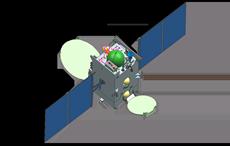Isro’s GSLV-09 successfully places South Asia Satellite in orbit
05 May 2017
The Indian Space Research Organisation (Isro) today successfully launched the `South Asia Satellite', a project that will benefit the countries of the South Asian region.
 Isro's Geosynchronous Satellite Launch Vehicle (GSLV-F09) carrying GSAT-9, lifted off from the second launch pad (SLP) at the Satish Dhawan Space Centre SHAR (SDSC SHAR) at Sriharikota.
Isro's Geosynchronous Satellite Launch Vehicle (GSLV-F09) carrying GSAT-9, lifted off from the second launch pad (SLP) at the Satish Dhawan Space Centre SHAR (SDSC SHAR) at Sriharikota.
The South Asia Satellite or GSAT-9 costs around Rs235 crore and is meant for providing communication and disaster support and connectivity among the countries of South Asia region.
India's 'priceless gift' to South Asian nations will, however, not benefit Pakistan, which had opted out of the project when Prime Minister Narendra Modi proposed it in 2014.
''I congratulate the team of scientists who worked hard for the successful launch of South Asia Satellite. We are very proud of them. The historic occasion has been made better with a surprise- we have leaders of South Asian nations joining us in celebrating this launch. I welcome President Ashraf Ghani, PM Hasina, PM Tshering Tobgay, President Abdulla Yameen, PM Prachanda, President Maithripala. All the leaders will take part and address the programme via video conferencing at 5.30 PM this evening,'' PM Modi tweeted.
GSAT-9 is a Geostationary Communication Satellite with the objective to provide various communication applications in Ku-band with coverage over South Asian countries. GSAT-9 is configured around the Isro's standard I-2K bus, with lift off mass of 2,230 kg. The main structure of the satellite is cuboid in shape built around a central cylinder with a mission life of more than 12 years.
GSLV-F09 mission is the eleventh flight of GSLV and its fourth consecutive flight with the indigenous cryogenic upper stage (CUS).
GSAT-9, which will provide communication links to seven regional countries - the entire membership of the South Asian Association for Regional Cooperation (SAARC) minus Pakistan - cost India Rs450 crore for its launch.
Isro built the 2,230-kg satellite, which uses a new propulsion system, over three years at a cost of Rs235 crore.
With a mission life of 12 years, the satellite will provide telecommunication links between India, Nepal, Bhutan, Bangladesh, Maldives, Sri Lanka and Afghanistan.
Each country can beam its own TV programmes while there will be the possibility for a common South Asia programming.
The satellite will help the nations communicate better during disasters and it could help establish a hotline among them. The functions of the South Asia satellite will include telemedicine and education.
The satellite has 12 Ku band transponders - devices that help in communication. Each nation will get access to at least one transponder. India said it was ready to help them with the ground infrastructure.
If the GSAT-9 meets its objectives, New Delhi will be better equipped to lead regional efforts in humanitarian aid and disaster relief operations (HADR), weather monitoring, and telemedicine in a disaster prone region.
Further, a South Asian Satellite would greatly enhance the region's capacity for collaborative Maritime Domain Awareness (MDA). Currently, no single country in the region possesses the resources for comprehensive MDA.
Beyond regional communications, HADR and MDA, regional satellite linkages could also be gradually expanded into collaborative weather forecasting and studying the effects of global warming, drawing in partners from the wider Indo-Pacific region like Indonesia and Australia.













.jpg)






.jpg)









